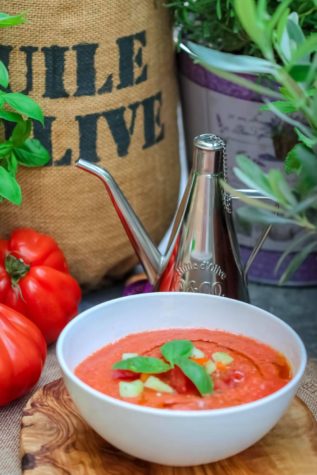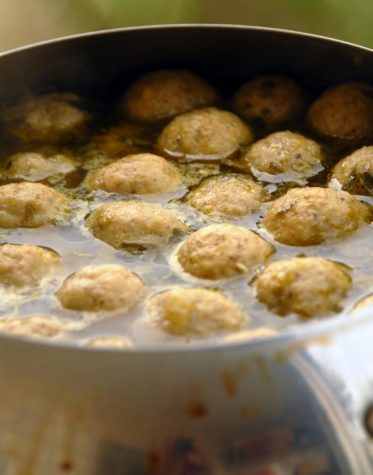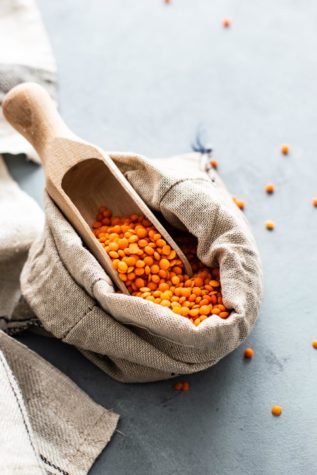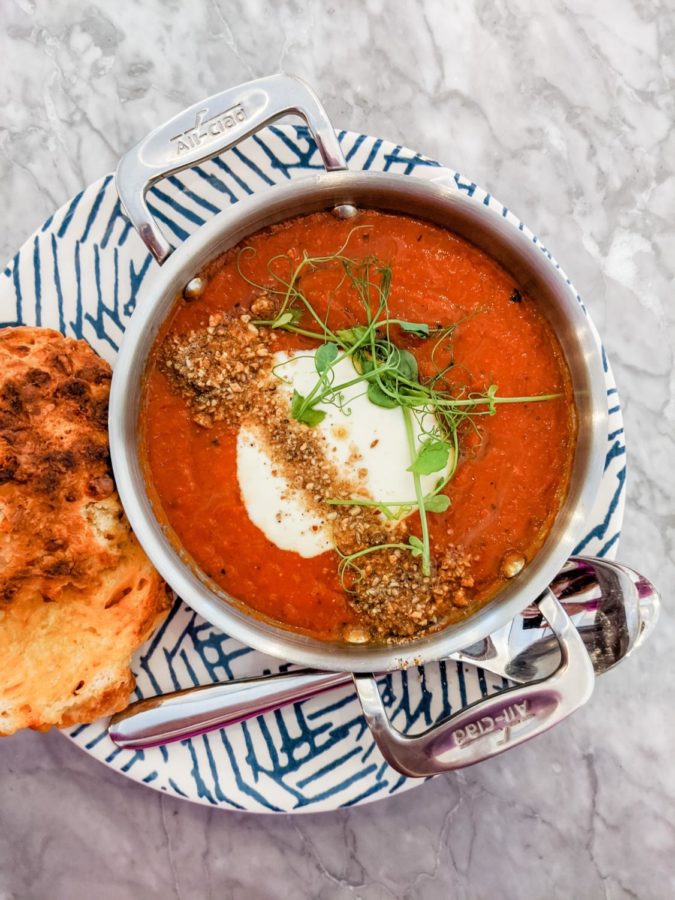Soup-eriority: A Profile on Soups
Soup, in all of its universality, can hardly be honored in a single article. However, here are several highlighted recipes.
Tomato soup, often paired with a grilled cheese sandwich for a classic rainy-day meal.
The Oxford English Dictionary defines soup to be “a liquid food prepared by boiling, usually consisting of an extract of meat with other ingredients and seasoning.” Due to the open-ended nature of the definition, soup has become something so universal that nearly every single culture has its own version of the dish. From cold gazpacho to creamy bisque, french onion to ramen, and thousands of other options, soup is a near perfect food foundation. The concept is simplistic and easily customizable, creating a blend of flavors and textures that taste like home.
Contained within the following article are interviews and recipes that I collected from fellow Bronx Science students. Everyone’s soup, or memories of their preferred soup, had different memories or hints of nostalgia intertwined with the flavors. While some elected to stick to the classics, others discussed dishes with cultural roots.
A Soup as Old as Thyme
There are certain memories that instantly jump to mind upon hearing the word “soup.” Many students recall with fond memories sick days punctuated by steaming bowls of chicken soup, or grilled cheese and tomato soups served within the sanctity of a cozy home. As Astrid Grimskog-Tran ‘26 put it, “Rainy day, sofa, blanket, ATLA on the T.V., no spoon, just sipping soup with a cheese sandwich.”
Such memories do not need to be backed with intricate dishes and hours of labor in the kitchen. In fact, some of the simplest items can bear fruit to equally simple times and childhood nostalgia. “It’s canned soup that is creamy and really nice when warmed up,” said Grimskog-Tran. “My mom always made it for me.” And therein lies the essence of soup. At heart, soups are simple dishes, able to be packaged in a single can and served without any bells and whistles. Food is a necessity, and enjoying comfort foods without the need to whip up an extravagant dish can mean a lot. Accessibility is an important, but often overlooked, aspect of food.
Even the simple act of picking up an order of soup can lift one’s spirits and brighten their day. Matthew Emer ’26 describes his favorite soup; chicken and rice from a restaurant in the Bronx. “My parents used to give it to me when I was sick or as a reward,” said Emer. Like many others, he associates soup with the idea of comfort and positive emotions.
The soup is a treasured classic, and even has books published in its name. A miniature version of Chicken Soup With Rice by Maurice Sendak sits on my bookshelf as I write this profile, bringing back memories of bedtime stories and my brother, who loves to have any meal with rice. Matthew Emer’s specific soup can be found at the following address: New Green Dragon restaurant at 4111 E Tremont Ave, Bronx, NY. “I remember going to family dinners and sharing memories with my brother and sister while having this soup at the restaurant,” he reflects.
Just as chicken soup and rice can bring together a family at dinnertime, soups are often enjoyed by a large group of people. Zachary Fischbarg ’26 talks about a soup familiar to many: alphabet soup. This dish appeals to everyone in the family, from young kids who can play with their food and create pasta words on their spoons to those who enjoy the taste and eating pasta with their soup. There are even recipes to make a homemade vegetable soup version, which is both parent and child approved.

Alphabet soup can be made from scratch (Fischbarg recommends this recipe), or found at a local store. “Most restaurants do not have this soup on the menu, which is very unfortunate. However, you can find it in almost any grocery store,” said Fischbarg. Though not as complex as a french onion soup, alphabet soup is perfectly customizable. One could prepare it from a can and batch of pasta, adding in any desired spices and vegetables. The soup is typically served with a tomato soup base, but can be substituted with chicken soup for variety.
Classic soups are able to be enjoyed by everyone, no matter the location or ingredients available. Childhood should be filled with memories of warm soup and pasta, toasted bread for dipping, and any other ingredients that make the experience special. “Whenever I used to come home from elementary school and smell alphabet soup, I knew it was going to be a good night,” said Fischbarg.
A Mother’s Touch
There are several common love languages – physical touch, words of affirmation, and gift giving, among others. Within these broader categories, however, food exists as its own language of love. Making someone food, especially as a form of comfort, is something that often ties into memories of childhood nostalgia.
Renner Ashley ’26 has grown up with her mother’s homemade chili recipe, and finds no other dishes comparable. “I first had the dish when I was really young… maybe three or four? And I found out about it through my mom, because she makes the best chili,” said Ashley. Especially for busy parents, food is one way to express love and care while keeping everyone fed.
For many, dishes such as soup are simple to make yet always a source of comfort to rely on. “My parents have made [lentil soup] for me and over the years it became a normal winter time dinner,” said Caroline Ferrell ’26. “ I don’t care for some lentil soup, so that just makes a good bowl of it that much better.” Progresso, a brand known for making high quality canned soup, includes vegetables, proteins and more to provide a filling and delicious meal without intensive preparation.
Mason Koelbel ’26 can attest to the spirit-lifting qualities of a soup. “I had had a particularly rough day, and then the announcement came out that we were going to be eating broccoli cheddar soup for dinner. I was so unbelievably excited for this stupid soup,” said Koelbel. Broccoli cheddar soup is a hearty soup often served with bread or bread bowls.
Koelbel has only words of praise for the dish, even going so far as to say, “I wish I bled broccoli cheddar soup, simply so that I could wake up each day with a pep in my step, knowing that I have my beloved broccoli cheddar soup coursing through my veins.” When asked about the qualities of the soup that make it so compelling and delightful, they were just as passionate. “It is spoonfuls upon spoonfuls of pure unadulterated delight, and it warms my specialized school-embittered soul from its depths,” said Koelbel.
Koelbel describes their first experience with broccoli cheddar soup as a homemade treat made by their mother, and there is nothing more compelling and convincing than that, which I could add. Mothers, or any caregiver, add an elevating touch to dishes in a way that nothing else can match.
The Coolest Soups
While I was in the process of drafting this article, fellow editors brought it to my attention that the days were simply getting too warm to enjoy hot soups or stand by a stove in the heat, which was the exigence or my writing of this article section — a breakdown of multiple soups meant to be served cold.

One of the first dishes that come to mind upon hearing the words “cold soup” is likely gazpacho. This Spanish soup calls for several pounds of fresh tomatoes, along with onions, peppers, cucumbers, and garlic. Though it is most commonly made from scratch, the soup comes together quickly.
Its base liquid is tomato juice, and all the ingredients are raw. Gazpacho has a specific texture to it, and one tip people suggest is to add bread to the soup and blend until smooth. It may sound strange, but it rounds out the taste of the soup and thickens the mixture.
The Spanish-speaking region, Andalusia, were the first to make gazpacho, and their recipe embodies the classic cold soup. Over time, different regions have adapted it to their own liking, adding certain herbs and vegetables or making substitutions. Despite its different nature, there is no doubt that gazpacho is a soup in the same way that chicken noodle soup is one.
That being said, it is true that most of the known cold soups are not of American origin, or considered “classics.” Take one of my all-time favorite soups, for example.
My dad would tell us (my siblings and I) that when he was in Korea, and the summers were scorching hot and the humidity thickened the air even through the night, that they rarely had air conditioning. Mul-naengmyeon was his air conditioning.
Mul-naengmyeon, often shortened to just naengmyeon, is a Korean cold noodle dish made from buckwheat noodles and served with icy broth. The broth is a refreshing liquid, made from Korean water radish kimchi, and cuts through sun-beaten afternoons and the lingering aroma of sunscreen without fail. The noodles are thin and chewy, yet still able to pick up the flavor of the soup.
We typically eat our naengmyeon with fresh-sliced cucumbers and a generous portion of a sweet-and-spicy gochujang paste. By technicality, adding the red paste means the dish is closer to bibim-naengmyeon than mul-naengmyeon. Bibim is a word that translates directly to “mixed,” though is often associated with “spicy.” Bibimbap, for example, is mixed rice, vegetables, and meat in a hot stone bowl, often served with gochujang.
A Spoonful of Culture
Samuel Halpern ’26 has a favorite soup, and it is one that he has grown up with. Typically homemade, but also found in restaurants or delis, matzo ball soup to Halpern is associated with “every holiday, ever.” The soup is of Ashkenazi Jewish origin, and a Passover staple. “I’ve always known about it, because I’m Jewish,” adds Halpern.

Matzo (also spelled matza, matzah, matzoh, but always in the food industry as matzo), is a thin, unleavened bread. The bread is consumed on Passover in remembrance of its story, that of freed Hebrew slaves fleeing from Egypt. There are multiple versions told, but the most common is that while fleeing, the Israelites did not have the time to allow their bread dough to rise, and simply took their unleavened loaves with them. The dough must be baked within an 18-minute time frame after mixing in order to ensure it does not rise.
Though the presence of matzo and matzo ball soup may be a tradition, everyone has their own slightly different way of making the dish. Here is one recipe with thorough reviews of all variations on a matzo ball, photos and measurements included.
There is the debate between the preferred fluffiness of the matzo balls. Lighter balls are known as “floaters” and denser ones as “sinkers.” Floaters often require additional leavening ingredients, such as baking soda, which has stirred debate over whether it belongs on the Passover table, as the holiday forbids the use of leavening ingredients. Next, there are choices to make in regard to the matzo meal used. While some find a store bought package of ready-to-go matzo meal more convenient, others insist upon hand-crushing matzo to create the perfect consistency.
When the matzo meal is prepared, it is ready to be combined with eggs and schmaltz–rendered chicken fat– that will add flavoring while binding the ingredients together. Here is yet another varying point in the recipe, as each cook has a different preferred liquid to add. Some elect to stick with a simple mixture of salted water, while others like to cook the matzo balls in the chicken stock for added flavor. Certain recipes even call for the use of club soda or a seltzer to best “aerate” the ball.
Matzo-ball mixture should be refrigerated and rested for a half hour before attempting to form it. This allows the matzo meal to absorb all the different flavors and liquids, as well as maintain a beautiful round shape when cooked.

Once the dough has been refrigerated and has come together, it is time to make the balls and cook them. The best way to roll the mixture is to wet your palms slightly first, then use a spoon or scoop to grab the right amount. Work quickly and transfer to an oiled platter before cooking. Afterward, the prepared matzo balls are cooked in a pot of boiling salted water for half an hour. Once cooled, they are ready to serve with the chicken soup.
Although the matzo balls are where this dish gets its name, the soup is far more time-consuming to make. Recipes for the soup base call for one whole chicken, along with an assortment of other vegetables, to simmer and flavor the broth. Simmering can take hours in order to properly extract all of the rich flavors and cook the chicken.
It is interesting that matzo ball soup, which is, at first glance, straightforward, opens conversations to dozens of different possibilities and combinations of ingredients. Different recipes claim to be the best, each offering a slightly different take on the making of a matzo ball.
While some recipes can be contested and still the point of discussion for generations after generations, others remain untouched by time.
Alexander Kousoulas ’26 has a favorite soup, Greek Lentil soup made by his grandmother; it is the type of meal made again and again without a recipe, reliant on the skillful hands of a loved one. The dish, translated to “Fakes Soupa” in Greek, is full of herbs and spices to add flavor and dimension. This classic Greek soup has been passed down through generations without fail, with a fairly straightforward recipe sure to delight. “The way my grandma cooks the soup is unparalleled. She uses Greek olive oil, Greek lentils, chopped up carrots, and fresh garlic. It is an exquisite dish that I look forward to!” said Kousoulas.
Though the following recipe does not come from Kousoulas’ grandmother, Greek lentil soup is a delicious and uncomplicated dish to make. Healthy and filling from the bounty of lentils and hints of garlic, oregano, and tomato paste, the soup has been well-loved and crafted to perfection.
The Greek soup is known for its vinegar tang, which it gets from being prepared with red wine vinegar and a drizzle of olive oil.

Lentils, which fall under the category of legumes, are thought to have originated in the Mediterranean area and hold the title of the oldest “pulse crop,” or crops harvested for their dry seeds. Common pulse crops include chickpeas and peas, which grow in pods that protect the “pulses.” Throughout time, lentils have been served to royalty and lower-classes alike. While often overlooked, perhaps due to their unremarkable appearance, lentils are a great source of protein available at a low price. Most supermarkets sell the pulses for around $0.30 a pound, which is enough for at least four servings of fakes, depending on the recipe you choose. Though a pound may sound like too much, there is no shortage of ways to use them up, from salads and tacos to roasts and even cookies. Plus, lentils are chock-full of potassium and fiber, and thus helpful in managing blood sugar, cholesterol levels, and more.
Food is an excellent way to access one’s culture, and soup is a perfect starting point. Many cultural dishes can be complex, or require certain ingredients not widely available. However, most soups only require vegetables, protein, and a liquid base enhanced with spices. The internet is always a good resource for finding simple recipes, even with limited ingredients or knowledge. Furthermore, the internet has allowed many to access cultures other than their own through the use of food.
Culture Through Different Lenses – A Melting Pot
While soup can often be tied to culture and familial roots, the simplicity and accessibility of the food means that anyone can make a soup of their own. Food transcends culture, which means that every pot of boiling water or pile of spices is a doorway to unlock.
During the outlining process of this piece, I made sure to include space for a section on non-traditional soups, or soups that did not necessarily have cultural ties. Thankfully, I found my interviewee with ease.
Karishma Ramkarran ’23 was just as, if not more, enthused about “the soup article” than I was. The dish she was looking forward to sharing with the world was a Potato Dill Soup, or “Koperkowa,” and it was a recipe sourced online. Though Ramkarran herself is not Polish (the recipe is Polish-style), her interview allowed me to tie this entire article together. Soup is something universal, a shared memory and comfort food no matter its origin. “The first thing about soup is that it’s such a great dish because it’s so comforting, and I think that every household always has some kind of soup, no matter what kind of culture you come from,” said Ramkarran.
And while the classics are perfect go-tos for a day at home, there is also something special in finding a dish and making it your own. In the age of the Internet, finding recipes that would normally be passed down by families through the well-loved pages of a hand-written cookbook takes significantly less time and effort. Though some may argue that there is more value in family-famous recipes, at the end of the day soup is something to be shared.
From soups that are made just for that (hot-pot; a shared pot of bubbling broth for everyone to cook their ingredients in before enjoying in smaller bowls) to recipes that can easily be adjusted for one person or twenty, there is nothing to bring a group of people together like sharing a meal. Soup is also an accessible meal that can bridge more than just cultural differences. As Ramkarran puts it, “not everyone can have a gourmet meal every day, and soup is one of those things where you can put everything in a pot and see what works.” She’s right – most soups only require a simple liquid base and a slew of vegetables or protein options. The term “soup” itself refers to a very vague concoction, leaving a lot up to interpretation. But despite the abundance of available options, soups always seem to hit the nail on the head in terms of flavor profiles and enjoyment.
Take Polish Dill Soup as an example. Bundled within one dish was creaminess, freshness, and a citrus tang. Soups are easy enough to craft and consume without much of a second thought, which is why creating a specialty soup such as this one can make the meal stand out. Dill, an herb often described as “slightly grassy” and commonly used in pickling to accentuate an herb-like quality, serves as the star for this one. “That’s what made this soup so good; the dill. Because the dill was just so fresh tasting, and we had some lemon in there, which was good, a little heavy cream and potato, and it was a really great flavor combination,” said Ramkarran.
Unlike baking, where measurements are often required to be weighed in order for everything to come together and bake properly, simmering a soup is easily customizable and adjustable. This is another important aspect of food. Family-sourced recipes, for example, may stay the same for hundreds of years without any improvements or tweaks, tradition keeping any experimentalists at bay. With the introduction of a wide database of other recipes and solutions, however, soup customization is easy and guided.
Despite being entitled “Potato Dill Soup,” the writer links instructions for making the soup with rice, pasta, egg noodles, boiled eggs, and even meatballs. This open mindedness and understanding of people’s dietary restrictions or differing preferences allows the recipe to be enjoyed by a larger audience.
Upon reflecting on her experience making the Polish-based soup, Ramkarran has one final comment. “Brava. Brava to the Polish.”
“It is spoonfuls upon spoonfuls of pure unadulterated delight, and it warms my specialized school-embittered soul from its depths,” said Mason Koelbel ’26.
Sam Chin is an Editor-in-Chief and Chief Graphic Designer for ‘The Observatory’ yearbook and a Staff Reporter for 'The Science Survey' newspaper. In...











